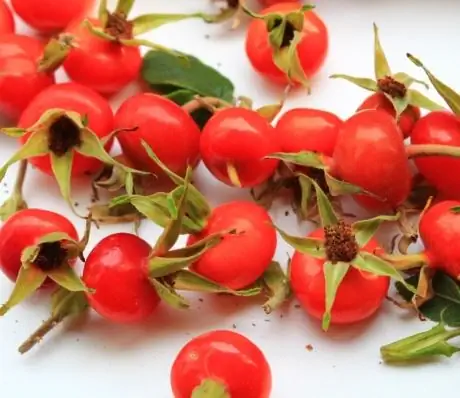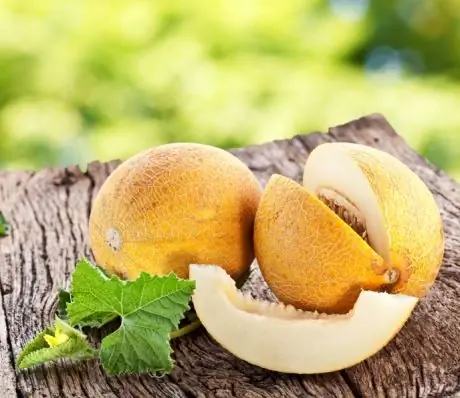- Author Rachel Wainwright [email protected].
- Public 2023-12-15 07:39.
- Last modified 2025-11-02 20:14.
Hydrangea
Instructions for use:
- 1. Chemical composition
- 2. Useful properties
- 3. Indications for use
- 4. Contraindications
- 5. Home remedies

Treelike hydrangea is a deciduous shrub up to 2.5-3 m in height, with a branched root system and bare or slightly pubescent reddish-brown shoots. Broadly oval leaves with serrated edges, 8-15 cm long, are located opposite, the crown of the shrub is broadly spreading, openwork, can reach a diameter of 2 meters.
The area of distribution in natural conditions is the east of North America, where it comes from. The plant is cultivated everywhere, grows in the south of Russia.
Chemical composition
The hydrangea tree contains: febrifugin and other alkaloids, flavonoids (luteolin, quercetin, cyanidin and kaempferol), coumarins (umbelliferone, neohydrangin, ellagic acid, hydrangetin), saponins, rubber, essential oils, rutin, carbohydrates, glycosides hydragin. The seeds of the plant contain a large amount of alkaloids.
Beneficial features
- moderate wound healing and diuretic;
- detoxification (elimination of toxins through the kidneys);
- normalizing water-salt balance (used in the treatment of edema, salt diathesis, chronic diseases of the urinary system);
- promotes the excretion of uric acid (prevents the deposition of salts in the joints and urinary tract);
- antimicrobial.
Indications for use
The leaves, flowers and roots of the hydrangea tree are widely used in folk medicine for the following conditions / diseases:
- infectious and inflammatory diseases of the urinary organs, gout, a tendency to form stones in the kidneys and urinary tract, fluid retention in the body (as a cleansing agent);
- helminthiasis;
- pustular skin lesions, toxicoderma;
- heart disease;
- dyspepsia;
- tonsillitis, tonsillitis, stomatitis, other inflammatory diseases of the oral cavity;
- severe course of premenstrual syndrome;
- diseases of the prostate gland;
- malaria;
- autoimmune diseases (as an adjuvant);
- cholelithiasis (as a lung choleretic);
- diabetes.
Contraindications
Medicines containing the raw hydrangea tree are contraindicated during pregnancy and breastfeeding, in childhood, as well as with individual hypersensitivity to the plant.
Home remedies from Hydrangea tree
- infusion 1: pour 1 cup boiling water over 1 dessert spoon of a mixture of leaves and flowers, bring to a boil, leave for 1 hour, drain. Take warm infusion for half an hour before meals with tonsillitis and sore throat for 1 / 2 cup 3 times a day. Duration of treatment - until the inflammation stops;
- infusion 2: pour 1 glass of boiling water 2 teaspoons of fresh crushed leaves, leave under the lid for 1 hour, drain. Take with diarrhea 15 minutes before meals, 2 tablespoons of the infusion 3-4 times a day. Duration of treatment - until stool normalization;
- Flask 3: Pour 1 / 2 liters of boiling water 1 tablespoon chopped fresh leaf 2 chasa insist in a thermos, drain, squeeze feedstock. Use for pharyngitis, periodontal disease, stomatitis for rinsing the mouth or throat 4-5 times a day;
- Flask 4: Pour 1 / 2 liters of boiling water 1 tablespoon chopped fresh leaves, hold 10 minutes on low heat, leave 1 hour, strain and bring the boiled water to a volume of 1 / 2 liters. Use for furunculosis for lotions and washing the affected areas (you can also use fresh plant juice);
- tincture: finely chop fresh young leaves or branches, add alcohol in a 1: 1 ratio, insist. Take for treating urinary tract and prostate by 1 / 2 teaspoon 2 times per day;
- broth: pour 1 glass of water 10-12 g of dried and crushed roots, boil for 1 hour, strain and bring boiled water to the original volume. Take as a diuretic 2 tablespoons 3 times a day.
Information about the drug is generalized, provided for informational purposes only and does not replace the official instructions. Self-medication is hazardous to health!






